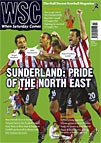 Andrew Turton reports on how Cardiff City’s move from Ninian Park began a battle for some slightly odd memorabilia
Andrew Turton reports on how Cardiff City’s move from Ninian Park began a battle for some slightly odd memorabilia
There were many who thought it would never happen, but this summer, Cardiff City move to their new home. A new stadium had been talked about for years, but Sam Hammam made it a priority on becoming chairman in 2000. Ironically, it was Hammam’s involvement that proved to be a stumbling block with the local authority after he fell out with council leader Rodney Berman, whom he was said to have persistently insulted at one of their many meetings. There was also some concern that Hammam would “do a Wimbledon” once he’d been handed the land. This had been given to the club on a dirt-cheap 999-year lease, which allowed them to sell on the leases to retail groups, including M&S, Costco and Asda. This provided most of the finance to build the new stadium. It was only when Hammam left the club three years ago that progress was made.
Hammam is now the public face of the club’s largest creditor, the mysterious Langston Corporation, which is owed between £18 million and £30m, depending on who you believe. Thankfully, the finances were in place before the current property crash. Ninian Park, opened in 1910, has been sold for housing and will eventually be bulldozed to make way for 124 homes.
Built on the site of the old car park, the new “Cardiff City Stadium” is just 50 yards from the old ground, and so for most those comforting pre-match rituals will remain in place. So far, Hammam’s successor, Peter Ridsdale, has been unable to secure a name sponsor, hence the uninspiring title – although many see this as a sly dig at the Cardiff Blues rugby side who will be City’s unwelcome tenants. Unfortunately, the team wasn’t able to provide the send- off that many had hoped for, with their play-off challenge collapsing completely in the final few games.
Despite its fearsome reputation among travelling fans, there’s no doubt that Ninian Park became a rusty, ramshackle old place. The last 99 years have alternated between expansion and downright neglect, with the emphasis on the latter; there can be few fans who genuinely wanted to stay. That said, supporters of all clubs come to love their grounds and Ninian Park was no exception.
There were plenty who wanted to take some part of the old stadium with them, with fans were stripping Ninian Park of anything they could prise loose long before the final game. Some were pictured in the local press, carting away doors and signs after the final home game, but for those who like to acquire their mementoes by legal means there was also an online auction.
The club had already sold off seats to season-ticket holders, but just about everything else was available. There were turnstiles, floor tiles, carpets, clocks, gates, goalposts, police cell doors (home and away), and the corner posts with the triangular flags that are apparently only permitted to FA Cup winners. The dug-outs were sold, along with the penalty and centre spots, plus lots and lots of signs. Unfortunately, a number had to be withdrawn, after they were “removed from the premises” during a recent open day.
Bidding was keen, but there were few bargains to be had – though of course, that depends on your point of view. The clock that has hung on the Grange End for all of five years went for a staggering amount – well over £1,000, once you’d paid the tax and premiums. The centre spot was £175, while simple perspex signs fetched between £75 and £150, depending on location. The sofa from the manager’s office was sold for £275, so the eventual buyer can relive their favourite signings (or sackings) in the comfort of their own home. Why anyone would pay £50 for the price list from a pie-stall defeats me, but I reckon they should have held on to the signs from the old Family Stand that appealed for fans to “refrain from using colourful language”. If there’s a repeat of last season’s collapse, they could well come in very handy.
From WSC 269 July 2009